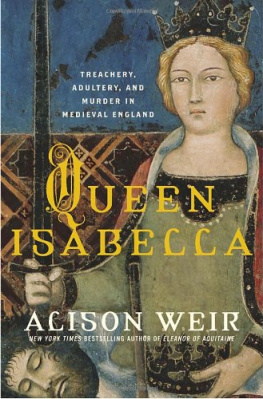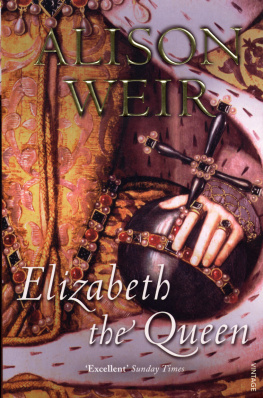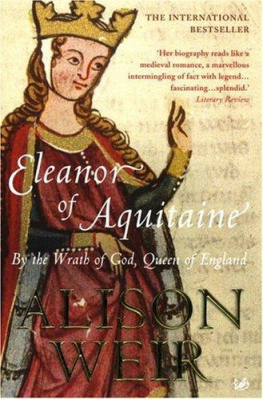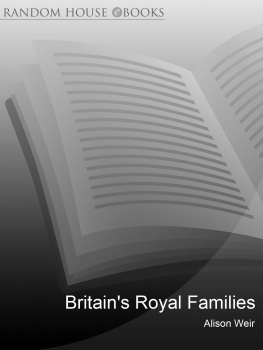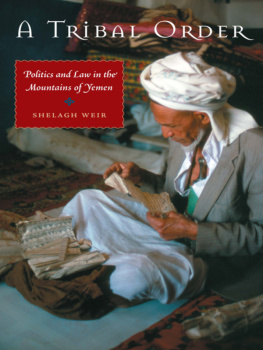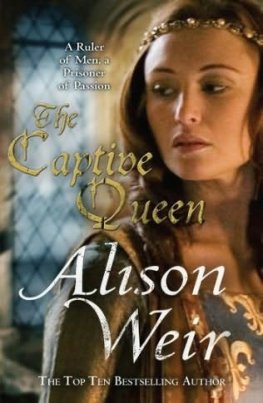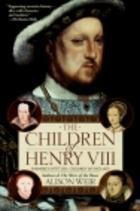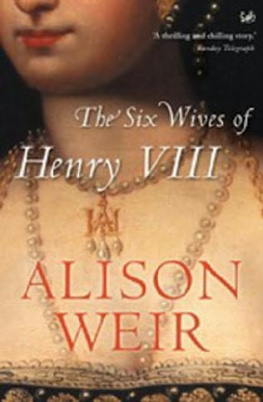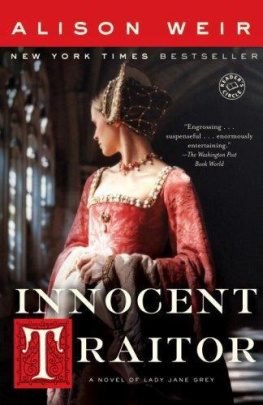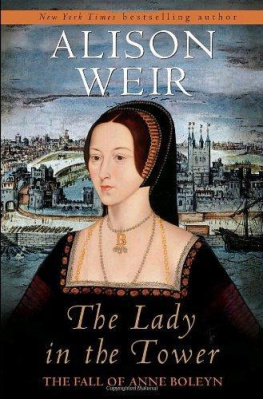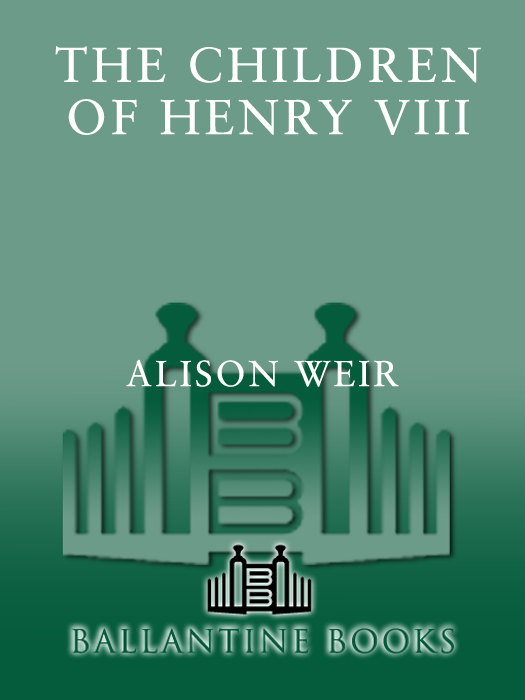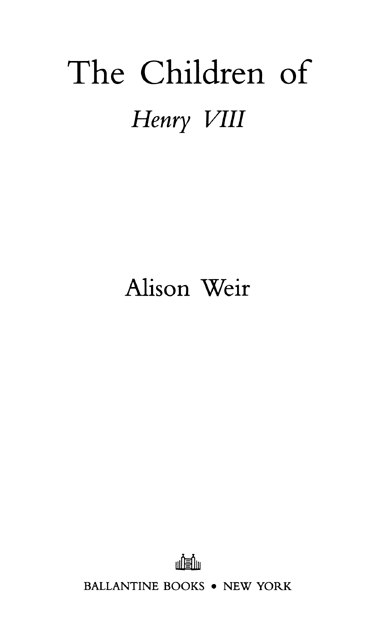2008 Ballantine Books Trade Paperback Edition
Copyright 1996 by Alison Weir
Reading group guide copyright 2008 by Random House, Inc.
All rights reserved.
Published in the United States by Ballantine Books,
an imprint of The Random House Publishing Group,
a division of Random House, Inc., New York.
B ALLANTINE and colophon are registered trademarks of Random House, Inc.
R ANDOM H OUSE R EADERS C IRCLE and colophon are trademarks of Random House, Inc.
Originally published in Great Britain as Children of England by Jonathan Cape, a division of Random House Group Ltd., London, in 1996.
Subsequently published in hardcover in the United States by Ballantine Books, an imprint of The Random House Publishing Group, a division of Random House, Inc., in 1996.
A trade paperback edition was published by Ballantine Books,
an imprint of The Random House Publishing Group,
a division of Random House, Inc., in 2007.
eISBN: 978-0-307-80686-4
www.randomhousereaderscircle.com
v3.1
Contents
Preface
T his book is not a history of England during the troubled reigns of Edward VI, Jane Grey, Mary I and Elizabeth I, but a chronicle of the personal lives of four English sovereigns, and the relationships between them, during the period 1547 to 1558. When Henry VIII died in 1547, he left three highly intelligent children to succeed him in turn Edward, Mary and Elizabeth, to be followed, if their lines failed, by the descendants of his sister Mary Tudor, one of whom was the ill-fated nine-days queen, Lady Jane Grey.
The relationships between the royal siblings were never easy ones for several reasons: all had very dissimilar characters, and while they took after their father in many ways, they had each inherited diverse characteristics from their mothers, who had been the first three of Henry VIIIs six wives. Each child had spent its formative years in vastly different circumstances, and had enjoyed or suffered varying relations with its formidable father. Marys mother had been supplanted in King Henrys affections by Elizabeths mother, who had, in her turn, been supplanted by Edwards mother. And while the Kings daughters suffered several vicissitudes of fortune in Henrys lifetime, his son grew up secure in his august fathers love and protection.
In the pages of this book, which begins at the point where my earlier book The Six Wives of Henry VIII came to an end, I have tried to portray the characters of these royal siblings and their cousin Jane Grey as realistically as possible, and to describe how their personal relationships with each other were affected by political and religious considerations. In order to achieve this, I have consulted a wealth of documentary evidence contemporary to the period, including numerous private and official letters, the great calendars of state and the masses of diplomatic papers, as well as memorials and chronicles by contemporary writers, including Edward VIs own journal, and more mundane records, such as lists of privy purse expenses, which can in fact yield fascinating information.
There have been many biographies of the later Tudor monarchs, but never a book in which their personal lives and relations with each other, and the effect of these factors upon the history of England, have been the central theme. One cannot of course write about kings and queens without touching on the political and social issues of their times, but what I have tried to bring into focus here is personal information that has until now been treated as generally subsidiary to the political ethos of other works. This book is not intended to replace such works, but to complement them.
In these pages, we go back in time to an age in which the personalities of monarchs and their familial connections had the power to influence governments, and it is vital to our knowledge of the period to understand what shaped the characters of these four monarchs, who were among the most charismatic and vivid personalities ever to have graced the throne of England. Naturally, our human condition makes us eager to learn about the private things, the everyday trivia, the scandals, and the sheer feel of ages long gone. We want to bridge the gap, to discover that even these long-dead kings and queens felt as we do, and come to know them through the writings and mementoes they have left behind. We are fortunate, therefore, that the Tudor period is one rich in source material, in which fascinating and sometimes astonishing discoveries may be made. These, and one or two tantalising mysteries, are the things I have included in this book, the things that bring us closer to the past.
Set against a background of turbulent change and intrigue, the story that unfolds will, I hope, bring to life four Tudor sovereigns and those whose lives they touched, and will portray them not only as Renaissance princes, but as individuals, who, in the final analysis, were people not so very unlike ourselves.
Alison Weir
Carshalton, Surrey
May 1996
Introduction: The Lions Cubs
T he Tudors were not a prolific race; although King Henry VIII of England married six times, only his first three wives bore him children, and of a probable total of eleven pregnancies between them produced only three surviving children. The fact that these royal heirs were born to different mothers would have a direct bearing on the history of England for several decades, for old grudges and jealousies and disagreements over religion remained lively in the hearts of these siblings until death divided them.
Henry VIII, who ascended the throne in 1509, was a true prince of the Renaissance, a brilliant scholar and sportsman whose good looks, splendid physique and kingly bearing were the talk of Christendom. The magnificence of his court attracted many great and learned men, and in the first half of his reign no expense was spared on lavish ceremonial and display. The young King delighted in tournaments and in sumptuous pageants based on classical or allegorical themes, and spent vast sums on costumes and scenery, much of which was made from cloth of gold. Later in his reign the more dramatic masque, an Italian novelty, became popular. Besides these more superficial entertainments, Henry delighted in the company of scholars, artists and musicians, and his court became a renowned centre of culture. It seemed that England had embarked upon a new golden age of glory and prosperity, and that Henry would found a dynasty that would surpass even the splendour and fame of the Plantagenets, whose throne the Kings father had usurped in 1485.
After his accession, Henry VIII wasted no time in marrying his sister-in-law, the Princess Katherine of Aragon, who had originally come from Spain in 1501 as the bride of his elder brother, Arthur, Prince of Wales. Arthur, however, had died six months after their wedding, and in 1509 Henry obtained a papal dispensation permitting him to marry his brothers widow, who possessed all the qualities and virtues required of a medieval queen. However, Katherine was unable to give Henry the one thing he wanted most: a male heir. Her three sons died at or soon after birth, as did one of her daughters; another daughter was stillborn. The only child of this marriage to survive was the Princess Mary, who was born on 18 February 1516 at Greenwich Palace.


